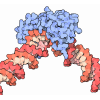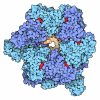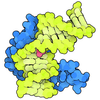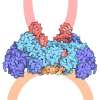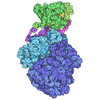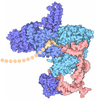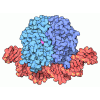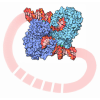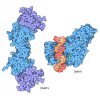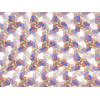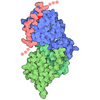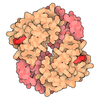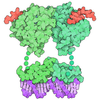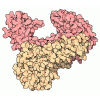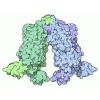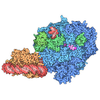+ Open data
Open data
- Basic information
Basic information
| Entry | Database: PDB / ID: 9p1d | ||||||
|---|---|---|---|---|---|---|---|
| Title | Cas1-Cas2/3 integrase bound to foreign dsDNA fragment | ||||||
 Components Components |
| ||||||
 Keywords Keywords | RECOMBINATION / CRISPR / integrase / type I-F | ||||||
| Function / homology |  Function and homology information Function and homology informationmaintenance of CRISPR repeat elements / DNA endonuclease activity / helicase activity / Hydrolases; Acting on acid anhydrides; Acting on acid anhydrides to facilitate cellular and subcellular movement / defense response to virus / Hydrolases; Acting on ester bonds / hydrolase activity / DNA binding / ATP binding / metal ion binding / identical protein binding Similarity search - Function | ||||||
| Biological species |  | ||||||
| Method | ELECTRON MICROSCOPY / single particle reconstruction / cryo EM / Resolution: 3.31 Å | ||||||
 Authors Authors | Henriques, W.S. / Bowman, J. / Hall, L.N. / Gauvin, C.G. / Wei, H. / Kuang, H. / Zimanyi, C.M. / Eng, E.T. / Santiago-Frangos, A. / Wiedenheft, B. | ||||||
| Funding support |  United States, 1items United States, 1items
| ||||||
 Citation Citation |  Journal: Structure / Year: 2025 Journal: Structure / Year: 2025Title: Structures reveal how the Cas1-2/3 integrase captures, delivers, and integrates foreign DNA into CRISPR loci. Authors: William S Henriques / Jarrett Bowman / Laina N Hall / Colin C Gauvin / Hui Wei / Huihui Kuang / Christina M Zimanyi / Edward T Eng / Andrew Santiago-Frangos / Blake Wiedenheft /  Abstract: Cas1 and Cas2 are the hallmark proteins of prokaryotic adaptive immunity. However, these two proteins are often fused to other proteins and the functional association of these fusions often remain ...Cas1 and Cas2 are the hallmark proteins of prokaryotic adaptive immunity. However, these two proteins are often fused to other proteins and the functional association of these fusions often remain poorly understood. Here we purify and determine structures of Cas1 and the Cas2/3 fusion proteins from Pseudomonas aeruginosa at distinct stages of CRISPR adaptation. Collectively, these structures reveal a prominent, positively charged channel on one face of the integration complex that captures short fragments of foreign DNA. Foreign DNA binding triggers conformational changes in Cas2/3 that expose new DNA binding surfaces necessary for homing the DNA-bound integrase to specific CRISPR loci. The length of the foreign DNA substrate determines if Cas1-2/3 docks completely onto the CRISPR repeat to successfully catalyze two sequential transesterification reactions required for integration. Together, these structures clarify how the Cas1-2/3 proteins orchestrate foreign DNA capture, site-specific delivery, and integration of new DNA into the bacterial genome. | ||||||
| History |
|
- Structure visualization
Structure visualization
| Structure viewer | Molecule:  Molmil Molmil Jmol/JSmol Jmol/JSmol |
|---|
- Downloads & links
Downloads & links
- Download
Download
| PDBx/mmCIF format |  9p1d.cif.gz 9p1d.cif.gz | 1 MB | Display |  PDBx/mmCIF format PDBx/mmCIF format |
|---|---|---|---|---|
| PDB format |  pdb9p1d.ent.gz pdb9p1d.ent.gz | 689.5 KB | Display |  PDB format PDB format |
| PDBx/mmJSON format |  9p1d.json.gz 9p1d.json.gz | Tree view |  PDBx/mmJSON format PDBx/mmJSON format | |
| Others |  Other downloads Other downloads |
-Validation report
| Summary document |  9p1d_validation.pdf.gz 9p1d_validation.pdf.gz | 1.5 MB | Display |  wwPDB validaton report wwPDB validaton report |
|---|---|---|---|---|
| Full document |  9p1d_full_validation.pdf.gz 9p1d_full_validation.pdf.gz | 1.5 MB | Display | |
| Data in XML |  9p1d_validation.xml.gz 9p1d_validation.xml.gz | 73.4 KB | Display | |
| Data in CIF |  9p1d_validation.cif.gz 9p1d_validation.cif.gz | 112.9 KB | Display | |
| Arichive directory |  https://data.pdbj.org/pub/pdb/validation_reports/p1/9p1d https://data.pdbj.org/pub/pdb/validation_reports/p1/9p1d ftp://data.pdbj.org/pub/pdb/validation_reports/p1/9p1d ftp://data.pdbj.org/pub/pdb/validation_reports/p1/9p1d | HTTPS FTP |
-Related structure data
| Related structure data |  71097MC  9p11C C: citing same article ( M: map data used to model this data |
|---|---|
| Similar structure data | Similarity search - Function & homology  F&H Search F&H Search |
- Links
Links
- Assembly
Assembly
| Deposited unit | 
|
|---|---|
| 1 |
|
- Components
Components
| #1: Protein | Mass: 121273.680 Da / Num. of mol.: 2 Source method: isolated from a genetically manipulated source Source: (gene. exp.)   References: UniProt: Q02ML8, Hydrolases; Acting on ester bonds, Hydrolases; Acting on acid anhydrides; Acting on acid anhydrides to facilitate cellular and subcellular movement #2: Protein | Mass: 36154.844 Da / Num. of mol.: 4 Source method: isolated from a genetically manipulated source Details: Strep-tagged Cas1 / Source: (gene. exp.)   References: UniProt: Q02ML7, Hydrolases; Acting on ester bonds #3: DNA chain | | Mass: 10377.702 Da / Num. of mol.: 1 / Source method: obtained synthetically / Source: (synth.)  #4: DNA chain | | Mass: 9959.435 Da / Num. of mol.: 1 / Source method: obtained synthetically / Source: (synth.)  Has protein modification | N | |
|---|
-Experimental details
-Experiment
| Experiment | Method: ELECTRON MICROSCOPY |
|---|---|
| EM experiment | Aggregation state: PARTICLE / 3D reconstruction method: single particle reconstruction |
- Sample preparation
Sample preparation
| Component |
| ||||||||||||||||||||||||
|---|---|---|---|---|---|---|---|---|---|---|---|---|---|---|---|---|---|---|---|---|---|---|---|---|---|
| Molecular weight | Value: 0.415 MDa / Experimental value: YES | ||||||||||||||||||||||||
| Source (natural) |
| ||||||||||||||||||||||||
| Source (recombinant) | Organism:  | ||||||||||||||||||||||||
| Buffer solution | pH: 7.5 | ||||||||||||||||||||||||
| Specimen | Conc.: 1.7 mg/ml / Embedding applied: NO / Shadowing applied: NO / Staining applied: NO / Vitrification applied: YES / Details: Monodisperse peak on SEC | ||||||||||||||||||||||||
| Specimen support | Grid material: COPPER / Grid mesh size: 300 divisions/in. / Grid type: Quantifoil R1.2/1.3 | ||||||||||||||||||||||||
| Vitrification | Instrument: FEI VITROBOT MARK IV / Cryogen name: ETHANE / Humidity: 100 % / Chamber temperature: 277 K |
- Electron microscopy imaging
Electron microscopy imaging
| Experimental equipment |  Model: Titan Krios / Image courtesy: FEI Company |
|---|---|
| Microscopy | Model: TFS KRIOS |
| Electron gun | Electron source:  FIELD EMISSION GUN / Accelerating voltage: 300 kV / Illumination mode: OTHER FIELD EMISSION GUN / Accelerating voltage: 300 kV / Illumination mode: OTHER |
| Electron lens | Mode: OTHER / Nominal magnification: 96000 X / Nominal defocus max: 2800 nm / Nominal defocus min: 900 nm |
| Image recording | Average exposure time: 6 sec. / Electron dose: 51.78 e/Å2 / Film or detector model: FEI FALCON IV (4k x 4k) / Num. of real images: 5552 |
- Processing
Processing
| EM software |
| ||||||||||||||||||||||||
|---|---|---|---|---|---|---|---|---|---|---|---|---|---|---|---|---|---|---|---|---|---|---|---|---|---|
| CTF correction | Type: PHASE FLIPPING AND AMPLITUDE CORRECTION | ||||||||||||||||||||||||
| Particle selection | Num. of particles selected: 1083100 / Details: crYolo | ||||||||||||||||||||||||
| Symmetry | Point symmetry: C1 (asymmetric) | ||||||||||||||||||||||||
| 3D reconstruction | Resolution: 3.31 Å / Resolution method: FSC 0.143 CUT-OFF / Num. of particles: 28665 / Symmetry type: POINT | ||||||||||||||||||||||||
| Atomic model building | Protocol: RIGID BODY FIT | ||||||||||||||||||||||||
| Atomic model building |
| ||||||||||||||||||||||||
| Refinement | Cross valid method: NONE Stereochemistry target values: GeoStd + Monomer Library + CDL v1.2 | ||||||||||||||||||||||||
| Displacement parameters | Biso mean: 92.2 Å2 | ||||||||||||||||||||||||
| Refine LS restraints |
|
 Movie
Movie Controller
Controller









 PDBj
PDBj
